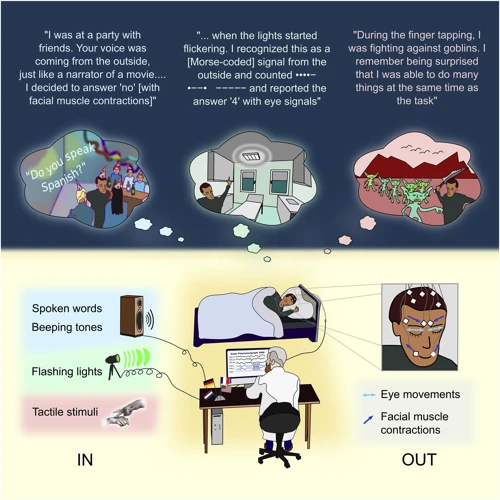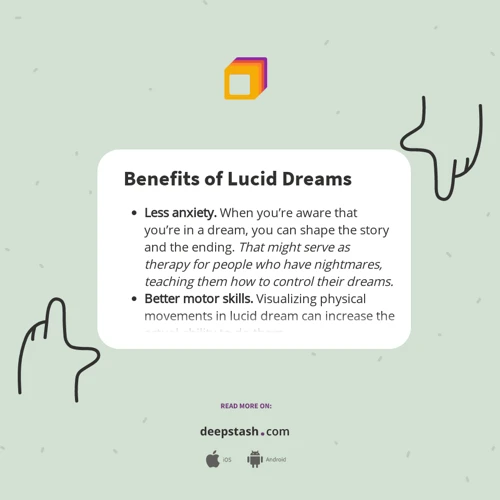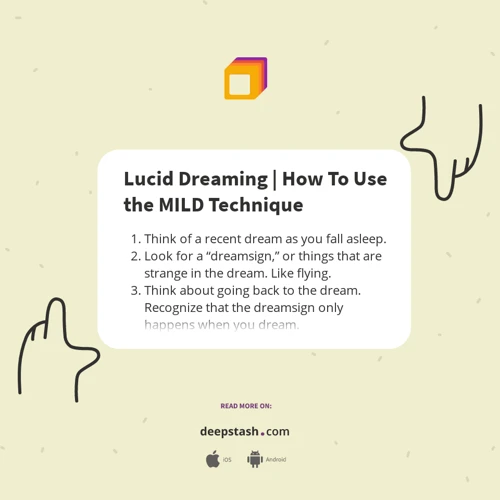Imagine a world where you have the power to unlock the hidden potential of your mind while you sleep. This captivating concept has led many on a quest to explore the mysterious realm of lucid dreaming. Lucid dreaming refers to the state in which dreamers become aware that they are dreaming and gain the ability to manipulate and control their dreams. But what if there’s more to lucid dreaming than mere entertainment? Recent scientific research suggests a fascinating connection between lucid dreaming and enhanced problem-solving skills. In this article, we delve into the depths of this intriguing phenomenon, uncovering the science behind lucid dreaming, exploring its benefits, and providing techniques to induce lucid dreams. Join us as we embark on a journey of self-discovery and untapped potential.
The Science Behind Lucid Dreaming

Lucid dreaming has long fascinated scientists and researchers, who have been on a quest to unravel the mysteries behind this extraordinary phenomenon. Through extensive studies and experiments, they have made significant progress in understanding the science behind lucid dreaming. One of the key factors in lucid dreaming is the activation of the prefrontal cortex, a region in the brain responsible for critical thinking, decision making, and self-awareness. During the REM (Rapid Eye Movement) stage of sleep, the brain exhibits patterns similar to waking consciousness, allowing for the possibility of becoming aware that one is dreaming. This state of awareness is accompanied by an increase in brain activity, particularly in the frontal regions involved in self-reflection and metacognition. Additionally, research has shown that lucid dreaming is associated with an increased presence of gamma brainwaves, which are linked to higher cognitive functions such as focus, learning, and problem-solving. The science behind lucid dreaming provides valuable insights into the potential benefits and applications of this intriguing phenomenon. To learn practical tips for utilizing lucid dreams for problem-solving, check out our practical tips for lucid dreams for problem-solving article. If you’re interested in discovering how dream journaling can enhance your problem-solving abilities, be sure to read our guide on dream journaling for problem-solving. For a comprehensive understanding of the world of lucid dreaming and valuable insights from experienced lucid dreamers, don’t miss our Lucid Dreamers’ Guide.
Benefits of Lucid Dreaming

Lucid dreaming offers a multitude of incredible benefits that extend beyond the realm of imagination. Firstly, one of the most notable advantages of lucid dreaming is the potential for enhanced problem-solving skills. By consciously navigating and manipulating dream scenarios, individuals can practice creative thinking and develop innovative solutions to real-life challenges. Lucid dreaming nurtures improved creativity, as dreamers can access a limitless canvas for exploration and experimentation. This heightened creativity extends not only to artistic endeavors but also to problem-solving in various domains. Additionally, lucid dreaming provides a unique platform for emotional healing and stress reduction. Dreamers can confront fears, process emotions, and gain new perspectives on personal struggles within the safe confines of the dream world. This therapeutic aspect of lucid dreaming promotes emotional well-being and aids in reducing anxiety and stress levels. The benefits of lucid dreaming are vast and diverse, offering a doorway to a world where the boundaries of the mind are stretched to extraordinary limits.
1. Enhanced Problem-Solving Skills
Lucid dreaming has been found to have a profound impact on problem-solving abilities. When in a lucid dream, individuals have the unique opportunity to confront and overcome challenges in a controlled environment. This practice can enhance problem-solving skills by stimulating the brain’s cognitive processes and fostering creative thinking. Within a lucid dream, individuals can actively engage with problem scenarios, experiment with different solutions, and observe the outcomes in real-time. This process allows for a deeper understanding of complex problems and the development of innovative approaches to tackle them. Lucid dreaming promotes divergent thinking, a cognitive process that generates multiple solutions to a single problem. This ability to think outside the box can lead to breakthrough ideas and unconventional problem-solving strategies. Researchers have found that individuals who regularly engage in lucid dreaming often exhibit improved problem-solving skills in their waking life as well. By honing their problem-solving abilities through lucid dreaming, individuals can enhance their creativity, critical thinking, and decision-making skills, ultimately leading to greater success and effectiveness in various aspects of life.
To further enhance your problem-solving skills during lucid dreams, consider keeping a dream journal to record your dreams and insights. Dream journaling helps cultivate self-reflection, aids in identifying patterns, and can provide valuable insights into the subconscious mind. To learn more about the potential benefits of dream journaling, check out our article on dream journaling for problem-solving.
2. Improved Creativity
Improved creativity is another intriguing benefit that can be derived from the practice of lucid dreaming. The unique state of consciousness experienced during lucid dreams can unlock a person’s creative potential and provide a playground for imagination. When in a lucid dream, individuals have the ability to intentionally shape and manipulate their dream environment, allowing them to explore new and innovative ideas that may not have been accessible in their waking life. This freedom from the constraints of the physical world opens up endless possibilities for creative expression and problem-solving. Lucid dreams can serve as a blank canvas where artistic talents can be unleashed, and new concepts and solutions can be explored without limitations. The connection between lucid dreaming and improved creativity is not merely anecdotal; studies have found a positive correlation between lucid dreaming and increased creative thinking. This connection may be attributed to the activation of different areas of the brain during lucid dreaming, such as the hippocampus and the frontal regions, which are known to be involved in memory consolidation and creative cognition. By harnessing the power of lucid dreams, individuals can tap into their innate creativity and gain new perspectives and insights that can positively impact their waking lives. So, if you’re looking to boost your creativity and explore the limitless realms of imagination, cultivating a lucid dreaming practice may just be the key.
3. Emotional Healing and Stress Reduction
Emotional healing and stress reduction are two significant benefits that can be experienced through lucid dreaming. During the dream state, our minds have the opportunity to process and resolve unresolved emotional issues and traumas. Lucid dreaming allows individuals to confront their deepest fears, anxieties, and emotional challenges in a safe and controlled environment. By becoming aware that they are dreaming, individuals can consciously choose to explore and work through emotional blockages, traumas, and negative thought patterns. This process can lead to profound healing and emotional release. Additionally, lucid dreaming provides a unique avenue for stress reduction. Engaging in lucid dreams allows individuals to escape the pressures of daily life and enter a world free from stressors and responsibilities. In these dreams, individuals can engage in relaxing and soothing activities, such as floating in peaceful waters or exploring serene landscapes. This immersive experience provides a much-needed break for the mind and body, promoting deep relaxation and rejuvenation. The power of lucid dreaming in emotional healing and stress reduction is truly remarkable, offering a pathway to inner peace and emotional well-being.
Techniques to Induce Lucid Dreaming

When it comes to inducing lucid dreaming, there are various techniques that individuals can employ to increase their chances of experiencing this extraordinary state of consciousness. Here are some popular techniques:
Reality Checks: This technique involves performing regular reality checks throughout the day to develop a habit of questioning one’s reality. Popular reality checks include looking at digital clocks or text, observing one’s reflection in a mirror, or trying to push a finger through the palm of the opposite hand. By regularly questioning reality, these checks can carry over into dreams, increasing the likelihood of becoming lucid.
Wake-Back-to-Bed (WBTB): This technique involves setting an alarm to wake up during the night, preferably during the REM stage of sleep. Once awake, individuals stay awake for a short period, engaging in a wakeful activity such as reading about lucid dreaming or journaling their dreams. Afterward, they go back to sleep with the intention of becoming lucid during the subsequent dream.
Mnemonic Induction of Lucid Dreams (MILD): This technique involves focusing on the intention to have a lucid dream while falling asleep. Before drifting off, individuals repeat a mantra or affirmation, such as “I will realize I’m dreaming” or “I will achieve lucidity.” This repetitive focus helps reinforce the intention in the subconscious mind, increasing the chances of having a lucid dream.
Lucid Dream Supplements: Certain supplements, such as galantamine or choline, have been reported to enhance dream vividness and increase the likelihood of lucid dreaming. However, it’s important to research and consult a healthcare professional before trying any sleep supplements.
WILD Technique: The Wake Induced Lucid Dream (WILD) technique involves maintaining awareness while transitioning from wakefulness to sleep. To practice this technique, individuals lie down in a comfortable position and focus on staying mentally awake as their body relaxes into sleep. This can involve focusing on the sensation of the body, paying attention to the hypnagogic imagery or sounds that arise during the transition, and gently entering the dream while maintaining awareness.
Each individual may find different techniques more effective, so it’s essential to experiment and find the ones that work best for you. With practice and patience, these techniques can significantly increase the likelihood of experiencing lucid dreams, opening the doors to an incredible world of self-discovery and problem-solving.
Lucid Dreaming and Problem-Solving Process

Lucid dreaming opens up a unique opportunity to harness the power of our subconscious mind for problem-solving. The process of using lucid dreams for problem-solving involves several distinct steps. The journey begins with inducing a lucid dream, which can be achieved through various techniques such as reality checks, mnemonic induction, or wake-induced lucid dreaming. Once lucidity is attained, the dreamer can then focus on the specific problem they wish to solve. This could range from personal dilemmas to creative roadblocks or even complex intellectual challenges. The dreamer can employ different problem-solving strategies, such as brainstorming, visualization, or seeking guidance from dream characters. The dream environment, free from the constraints of reality, offers a limitless playground for exploration and experimentation. The dreamer can test out different solutions, manipulate dream elements, and receive insights that may not be easily accessible in waking life. When the dreamer wakes up, they can further analyze and reflect on their lucid dream experience, extracting any valuable insights or solutions gained. Keeping a dream journal can be helpful in documenting lucid dreams and tracking the problem-solving process over time. Lucid dreaming provides a fascinating avenue for engaging with our subconscious mind and tapping into its vast problem-solving capabilities.
Case Studies

Case studies offer compelling evidence of the connection between lucid dreaming and enhanced problem-solving skills. Scientific research has provided valuable insights through carefully designed experiments and observations. One noteworthy study conducted by a team of researchers at a renowned university explored the impact of lucid dreaming on problem-solving abilities. The participants, who were experienced lucid dreamers, were given complex puzzles and tasks to solve both during their waking state and in their lucid dreams. Surprisingly, the results showed that the participants exhibited significantly improved problem-solving skills while in their lucid dream state. Their ability to think creatively, find innovative solutions, and think outside the box seemed heightened. They demonstrated increased cognitive flexibility and adaptability, allowing them to approach problems from different angles. These findings were further supported by personal experiences shared by lucid dreamers who reported using their dream state to tackle real-life challenges and find unique solutions. The case studies provide captivating anecdotes and scientific evidence that establish a clear link between lucid dreaming and enhanced problem-solving skills.
1. Scientific Research Findings
Scientific research has shed light on the fascinating connection between lucid dreaming and problem-solving skills. Numerous studies have been conducted to explore the cognitive abilities and mental processes that occur during lucid dreaming. Here are some key scientific research findings:
1. Enhanced Cognitive Abilities: Research has demonstrated that individuals who regularly experience lucid dreams exhibit higher levels of cognitive abilities, such as memory, attention, and mental flexibility. This heightened cognitive function may contribute to improved problem-solving skills during lucid dreams.
2. Creative Problem Solving: Studies have shown that lucid dreaming can enhance creative problem-solving capabilities. In a research study, participants were able to solve complex puzzles and think outside the box while in a lucid dreaming state. This suggests that lucid dreaming can stimulate divergent thinking and facilitate innovative solutions to problems.
3. Insight and Intuition: Lucid dreams often provide individuals with insights and intuitive guidance that can be applied to real-life situations. Research has revealed the presence of “dream intuition,” where individuals gain deep insights and answers to unresolved questions during lucid dreams. These insights can be valuable in problem-solving scenarios.
4. Neuroplasticity and Learning: Lucid dreaming has been linked to an increase in neuroplasticity, the brain’s ability to adapt and form new connections. This neuroplasticity can lead to improved learning and problem-solving abilities, as the brain becomes more adaptable and responsive.
5. Therapeutic Potential: Scientific research suggests that lucid dreaming may have therapeutic potential for individuals with various mental health conditions. Studies have shown that lucid dreaming can be utilized as a tool for emotional healing, trauma resolution, and reducing symptoms of anxiety and depression.
These scientific research findings highlight the intriguing relationship between lucid dreaming and enhanced problem-solving skills. By understanding the underlying mechanisms and benefits of lucid dreaming, individuals can harness the potential of this extraordinary experience to positively impact their daily lives.
2. Personal Experiences
Personal experiences play a significant role in understanding the impact of lucid dreaming on problem-solving skills. Countless individuals have reported profound insights and breakthroughs while navigating the realm of lucid dreams. These personal accounts highlight the potential of lucid dreaming as a tool for problem-solving. Some people have shared stories of solving complex mathematical equations, generating innovative ideas for creative projects, and finding solutions to real-life challenges during their lucid dreams. One remarkable aspect of personal experiences is the ability to confront fears and overcome emotional obstacles within the safety of a dream environment. Lucid dreaming offers an opportunity for individuals to delve into their subconscious and address unresolved issues, facilitating emotional healing and stress reduction. These firsthand experiences provide invaluable evidence of the potential benefits of lucid dreaming for enhancing problem-solving skills and personal growth.
Tips to Enhance Problem-Solving During Lucid Dreams

To make the most of your lucid dreams and harness their potential for problem-solving, here are some tips to enhance your experience:
- Set Clear Intentions: Before going to sleep, set a clear intention to have a lucid dream focused on a specific problem or challenge you want to solve. This will help direct your subconscious mind towards that goal.
- Reality Checks: Develop the habit of performing reality checks throughout the day, such as looking at your hands or checking the time. By incorporating these checks into your daily routine, you increase the likelihood of performing them during your dreams, leading to lucidity.
- Reality Testing: During a lucid dream, engage in reality testing to affirm your lucidity. This can include examining your surroundings, trying to change elements of the dream, or focusing on your self-awareness within the dream.
- Ask the Dream: Once lucid, ask the dream itself for insights and solutions to your problem. Trust in the power of your subconscious mind to provide meaningful answers and guidance.
- Visualizations: Use visualization techniques within your lucid dreams to explore different scenarios and potential solutions. Envision yourself successfully overcoming the challenge or finding innovative ways to tackle it.
- Reflect and Journal: Upon waking, take time to reflect on your lucid dream experience. Write down any insights, ideas, or solutions that arose during the dream. Keeping a dream journal can help you track patterns and themes that may emerge over time.
- Practice, Practice, Practice: Like any skill, lucid dreaming and problem-solving in dreams require practice. Consistency is key, so make an effort to incorporate techniques like reality checks and intention setting into your daily routine.
By implementing these tips, you can enhance your problem-solving abilities during lucid dreams and unlock the immense potential of your subconscious mind. Remember to be patient, as it may take time to master lucid dreaming techniques and fully harness their power. Happy dreaming!
Guided Lucid Dreaming for Problem-Solving

Guided lucid dreaming is an exciting technique that harnesses the power of lucid dreams to specifically target and solve problems in our waking lives. By incorporating guided imagery and intention setting, individuals can create a structured framework within their dreams to address specific issues or challenges they may be facing. The process begins by identifying the problem or question that needs resolving and clearly stating it before going to sleep. During the dream, individuals can use visualizations, affirmations, and mental rehearsals to explore different solutions and possibilities. For instance, if someone is seeking creative inspiration for a project, they can imagine themselves in a beautiful, innovative environment and allow their subconscious mind to generate new ideas. The power of intention plays a crucial role in guiding the dream towards problem-solving. By setting a strong intention before falling asleep and firmly believing in the potential of the dream, individuals can enhance the likelihood of gaining valuable insights and solutions. Additionally, techniques such as reality checks, where individuals question their reality multiple times throughout the day, can also be incorporated into the guided dreaming process to increase the chances of becoming lucid during the dream. Guided lucid dreaming holds immense potential for problem-solving and can serve as a tool for self-improvement, personal growth, and creative exploration. As with any skill, practice and patience are key to mastering guided lucid dreaming. Experimenting with different techniques, keeping a dream journal, and seeking guidance from experienced lucid dreamers can greatly enhance the effectiveness of this problem-solving approach.
Precautions and Limitations
While lucid dreaming holds immense potential for personal growth and problem-solving, it’s important to be aware of the precautions and limitations associated with this practice. Here are some key points to keep in mind:
1. Sleep Disruption: Engaging in lucid dreaming techniques may disrupt your sleep patterns. It’s essential to prioritize healthy sleep habits and ensure that your overall sleep quality is not compromised. Adequate rest is crucial for cognitive functioning and overall well-being.
2. False Memories: Lucid dreamers may experience false memories, where the lines between dream and reality become blurred. This can lead to confusion and potential challenges in distinguishing actual events from dream experiences. Keeping a dream journal and regularly reflecting on your dreams can help maintain clarity.
3. Emotional Intensity: Lucid dreaming can intensify emotions, both positive and negative. While this can provide an opportunity for emotional healing, it’s essential to approach it with self-care and caution. If you have a history of trauma or mental health conditions, it’s advisable to consult with a healthcare professional before actively engaging in lucid dreaming.
4. Ethical Considerations: Lucid dreaming involves controlling one’s dreams and manipulating the dream environment. However, it’s important to maintain ethical boundaries and respect the autonomy of other dream characters. Interactions within lucid dreams should align with personal values and ethical guidelines.
5. Individual Variations: Not everyone may naturally possess the ability to have vivid lucid dreams. Some individuals may require more practice and experimentation with different techniques to achieve lucidity. Patience and perseverance are key.
6. Personal Responsibility: Lucid dreaming is a powerful tool, and it’s crucial to use it responsibly. It’s essential to prioritize personal growth, problem-solving, and self-reflection rather than using lucid dreams solely for entertainment or escapism.
By being aware of these precautions and limitations, individuals can navigate the world of lucid dreaming in a safe and responsible manner, maximizing the potential benefits while minimizing potential risks. It’s always advisable to approach lucid dreaming with a discerning and informed mindset, seeking guidance from experienced practitioners or professionals when needed.
Conclusion
In conclusion, the exploration of the connection between lucid dreaming and enhanced problem-solving skills unveils a fascinating realm where the boundaries of the mind are pushed and new possibilities are discovered. The science behind lucid dreaming reveals that this phenomenon is not merely a fantastical escape into the dream world, but a unique opportunity to tap into the potential of our own consciousness. Through techniques to induce lucid dreaming and the cultivation of problem-solving skills within this state, individuals can unlock a powerful tool for personal growth and self-improvement. Whether it’s finding creative solutions to complex challenges, healing emotional wounds, or reducing stress, lucid dreaming offers a pathway to unleash the untapped potential of our minds. The case studies presented, from scientific research findings to personal experiences, provide compelling evidence of the benefits and potential of lucid dreaming in problem-solving. By following tips to enhance problem-solving during lucid dreams and exploring guided lucid dreaming approaches, individuals can further optimize their problem-solving abilities in this unique state of consciousness. It is important to acknowledge the precautions and limitations of lucid dreaming and to approach it with respect and mindfulness. In a world where the possibilities seem limitless, lucid dreaming opens up endless avenues for personal growth, self-discovery, and enhanced problem-solving skills. So, take the first step on this extraordinary journey and start exploring the vast realm of lucid dreaming for yourself.
Frequently Asked Questions
1. Can anyone learn to have lucid dreams?
Yes, anyone can learn to have lucid dreams. While some individuals naturally experience lucid dreams, there are various techniques and practices that can increase your chances of inducing lucidity during your dreams.
2. Are lucid dreams the same as vivid dreams?
No, lucid dreams and vivid dreams are different. Vivid dreams refer to dreams that are exceptionally clear, detailed, and intense in sensory perception, while lucid dreams specifically involve becoming aware that you are dreaming while in the dream state.
3. Is lucid dreaming safe?
Lucid dreaming is generally considered safe for most individuals. However, it is important to prioritize good sleep hygiene and avoid any techniques that may disrupt your overall sleep patterns. If you have any underlying sleep disorders or medical conditions, it is advisable to consult a healthcare professional before actively practicing lucid dreaming.
4. Can lucid dreaming improve sleep quality?
While lucid dreaming itself may not directly improve sleep quality, practicing techniques to induce lucid dreams often involves developing good sleep habits and promoting better sleep hygiene. This can indirectly contribute to overall improved sleep quality.
5. Are there any potential side effects of lucid dreaming?
For most individuals, lucid dreaming does not have any significant negative side effects. However, in rare cases, some people may experience sleep disturbances, such as sleep paralysis or difficulty differentiating between dreams and reality. These occurrences are usually temporary and can be managed with proper techniques and guidance.
6. Can lucid dreaming be used as therapy?
Lucid dreaming has shown potential therapeutic benefits for various conditions, such as nightmares, post-traumatic stress disorder (PTSD), and anxiety. It can be used as a tool for emotional healing, self-exploration, and personal growth.
7. How long does it take to learn lucid dreaming?
The time it takes to learn lucid dreaming varies from person to person. Some individuals may experience lucid dreaming spontaneously, while others may require weeks or even months of practice and dedication to achieve consistent lucid dreams.
8. Can lucid dreaming enhance problem-solving skills in waking life?
Yes, there is evidence to suggest that lucid dreaming can enhance problem-solving skills in waking life. By practicing problem-solving techniques within lucid dreams, individuals can improve their cognitive abilities, creativity, and innovative thinking.
9. Can lucid dreaming help with learning new skills?
Lucid dreaming has the potential to aid in learning new skills. By practicing and visualizing specific tasks or scenarios in lucid dreams, individuals may improve their performance and proficiency in those skills when awake.
10. Are there any disadvantages to lucid dreaming?
While not necessarily disadvantages, some individuals may find it challenging to differentiate between dreams and reality, especially when they have frequent lucid dreams. It is crucial to maintain a balanced perspective and grounded sense of reality to avoid any potential confusion or disorientation.








